Visualizing and Understanding Shrinking Cities and Towns (SCT) Research: A Network Analysis
Abstract
1. Introduction
2. Research Method
3. Results and Discussions
3.1. Mapping of Journals
3.2. Co-Authors Analysis
3.3. Countries Active in SCT Research
3.4. Citation of Articles
3.5. Co-Occurrence of Keywords
3.6. Discussions
- (1)
- Case study acted as a key research method for the existing SCT studies. From the existing literature, it is interesting to find that case study is a commonly used research method in existing studies. In the early research stage, case study was employed to investigate the characteristics of a particular shrinking city or town. For example, Wiechmann [64] selected Dresden as a case to study the strategic adjustment to cope with population reduction. Lee, et al. [67] conducted a case study in Incheon to describe the built environment changes of shrinking cities. Such studies could provide valuable information to enhance the knowledge of SCT; however, due to the spatial limitation and timeliness of data, the research results may be hysteretic so as to affect its reference value.
- (2)
- In the future, as the knowledge system of SCT needs to be broader, it could be foreseen that case study of a particular city or town will keep being a key research method in the field of SCT research. However, some other methods may also be proposed such as inductive analysis and data visualization method. The inductive analysis could explore the general laws and countermeasures of urban shrinkage, while the data visualization method provides a solid foundation for predicting, monitoring, and analyzing urban shrinkage.
- (3)
- Population and economy are the two important indicators to evaluate SCT. So far, the quantitative standard to define an SCT has not reached a consensus. Some scholars defined SCT from the population perspective. For example, Oswalt, et al. [68] proposed that the urban population reduced as much as 10% reached a shrinkage. Meanwhile, some scholars used economic indicators to characterize SCT. For instance, Malamud [69] proposed to use the unemployment rate which is closely relevant to the overall economy of the city to represent the shrinkage of the city. Moreover, Alves, et al. [70] identified SCT by using demographic and economic changes in geospatial and scenic features.
- (4)
- In the future, as SCT has swept throughout regions in both developed and developing countries, the evaluation criteria may be different by adding other indicators. For example, Schetke and Haase [71] believed that SCT could be calculated by parameters including the rate of building demolition and renovation. Bontje [72] proposed to use the vacancy rate to express urban shrinkage. The evaluation criteria should be determined considering the local economic and social situations.
- (5)
- Finding solutions for the SCT problems has become the emphasis in SCT research. Despite the early studies on SCT characteristics, the recent research attempted to answer the questions of how to avoid and solve the problems of SCT. Local governments have formulated various strategies to deal with urban shrinkage. For example, Hospers [73] identified four strategies for issues involving urban governance and planning to respond to urban shrinkage. Farhan et al. [74,75] sorted out the historical changes of Najaf City, and committed to promoting and activating the protection of architectural heritage to realize the revival of the old city. Among the proposed strategies, effective planning is the dominant one to deal with urban shrinkage. It was recommended that planners should not only be responsible for “planning for growth”, but also be prepared to “plan for shrinkage”. For example, how to accurately predict the population size and population structure in the backdrop of SCT [76], and how to adjust the supply of urban infrastructure to adapt to the size and structure of the new population [77]. In addition, Hollander and Németh [56] proposed to adopt the mode of smart decline, that is, the city should be planned in a scientific, reasonable and appropriate way to avoid vicious competition between cities.
4. Conclusions
Author Contributions
Funding
Institutional Review Board Statement
Informed Consent Statement
Data Availability Statement
Conflicts of Interest
References
- Tan, Y.T.; Xu, H.; Zhang, X.L. Sustainable urbanization in China: A comprehensive literature review. Cities 2016, 55, 82–93. [Google Scholar] [CrossRef]
- Lou, Y.; Shen, L.; Huang, Z.; Wu, Y.; Li, H.; Li, G. Does the Effort Meet the Challenge in Promoting Low-Carbon City?—A Perspective of Global Practice. Int. J. Environ. Res. Public Health 2018, 15, 1334. [Google Scholar] [CrossRef]
- Wu, Z.; Yu, A.T.W.; Shen, L. Investigating the determinants of contractor’s construction and demolition waste management behavior in Mainland China. Waste Manag. 2017, 60, 290–300. [Google Scholar] [CrossRef]
- Downs, A. The Challenge of Our Declining Big Cities. Hous. Policy Debate 1997, 8, 359–408. [Google Scholar] [CrossRef]
- Popescu, C. Deindustrialization and urban shrinkage in Romania. What lessons for the spatial policy? Transylv. Rev. Adm. Sci. 2014, 10, 181–202. [Google Scholar]
- Lee, J.; Newman, G.; Park, Y. A Comparison of Vacancy Dynamics between Growing and Shrinking Cities Using the Land Transformation Model. Sustainability 2018, 10, 17. [Google Scholar] [CrossRef]
- Kaluarachchi, Y. Potential advantages in combining smart and green infrastructure over silo approaches for future cities. Front. Eng. Manag. 2021, 8, 98–108. [Google Scholar] [CrossRef]
- Martinez-Fernandez, C.; Audirac, I.; Fol, S.; Cunningham-Sabot, E. Shrinking Cities: Urban Challenges of Globalization. Int. J. Urban. Reg. Res. 2012, 36, 213–225. [Google Scholar] [CrossRef]
- Döringer, S.; Uchiyama, Y.; Penker, M.; Kohsaka, R. A meta-analysis of shrinking cities in Europe and Japan. Towards an integrative research agenda. Eur. Plan. Stud. 2019, 28, 1–20. [Google Scholar] [CrossRef]
- Pallagst, K.; Fleschurz, R.; Trapp, F. Greening the shrinking city—policies and planning approaches in the USA with the example of Flint, Michigan. Landsc. Res. 2017, 42, 716–727. [Google Scholar] [CrossRef]
- Howe, S.R.; Bier, T.; Allor, D.; Finnerty, T.; Green, P. The shrinking central city amidst growing suburbs: Case studies of Ohio’s inelastic cities. Urban Geogr. 1998, 19, 714–734. [Google Scholar] [CrossRef]
- Zhang, L.; Sun, X.J.; Xue, H. Identifying critical risks in Sponge City PPP projects using DEMATEL method: A case study of China. J. Clean. Prod. 2019, 226, 949–958. [Google Scholar] [CrossRef]
- Neill, W.J.V. Carry on Shrinking?: The Bankruptcy of Urban Policy in Detroit. Plan. Pract. Res. 2015, 30, 1–14. [Google Scholar] [CrossRef]
- Banica, A.; Istrate, M.; Muntele, I. Challenges for the Resilience Capacity of Romanian Shrinking Cities. Sustainability 2017, 9, 20. [Google Scholar] [CrossRef]
- Bai, G.H.; Wang, H.; Zheng, X.Q.; Dui, H.Y.; Xie, M. Improved resilience measure for component recovery priority in power grids. Front. Eng. Manag. 2021, 8, 545–556. [Google Scholar] [CrossRef]
- Rhodes, J.; Russo, J. Shrinking smart?: Urban redevelopment and shrinkage in Youngstown, Ohio. Urban Geogr. 2013, 34, 305–326. [Google Scholar] [CrossRef]
- Hartt, M. The diversity of North American shrinking cities. Urban Stud. 2018, 55, 2946–2959. [Google Scholar] [CrossRef]
- Rink, D.; Haase, A.; Grossmann, K.; Couch, C.; Cocks, M. From long-term shrinkage to re-growth? the urban development trajectories of Liverpool and Leipzig. Built Environ. 2012, 38, 162–178. [Google Scholar] [CrossRef]
- Boustan, L.; Shertzer, A. Population Trends as a Counterweight to Central City Decline, 1950-2000. Demography 2013, 50, 125–147. [Google Scholar] [CrossRef]
- Bucek, J.; Bleha, B. Urban shrinkage as a challenge to local development planning in Slovakia. Morav. Geogr. Rep. 2013, 21, 2–15. [Google Scholar] [CrossRef][Green Version]
- Zaninetti, J.M.; Colten, C. Shrinking new Orleans: Post-katrina population adjustments. Urban Geogr. 2012, 33, 675–699. [Google Scholar] [CrossRef]
- He, S.Y.; Lee, J.; Zhou, T.; Wu, D. Shrinking cities and resource-based economy: The economic restructuring in China’s mining cities. Cities 2017, 60, 75–83. [Google Scholar] [CrossRef]
- Butters, C.; Cheshmehzangi, A.; Sassi, P. Cities, energy and climate: Seven reasons to question the dense high-rise city. J. Green Build. 2020, 15, 197–214. [Google Scholar] [CrossRef]
- Haase, A.; Rink, D.; Grossmann, K.; Bernt, M.; Mykhnenko, V. Conceptualizing urban shrinkage. Environ. Plan. A 2014, 46, 1519–1534. [Google Scholar] [CrossRef]
- Yang, L.; Liang, Y.; He, B.; Lu, Y.; Gou, Z. COVID-19 effects on property markets: The pandemic decreases the implicit price of metro accessibility. Tunn. Undergr. Space Technol. 2022, 125, 104528. [Google Scholar] [CrossRef]
- Yang, L.C.; Ao, Y.B.; Ke, J.T.; Lu, Y.; Liang, Y. To walk or not to walk? Examining non-linear effects of streetscape greenery on walking propensity of older adults. J. Transp. Geogr. 2021, 94, 103099. [Google Scholar] [CrossRef]
- Hartt, M.; Warkentin, J. The development and revitalisation of shrinking cities: A twin city comparison. Town Plan. Rev. 2017, 88, 29–41. [Google Scholar] [CrossRef]
- Wiechmann, T.; Pallagst, K.M. Urban shrinkage in Germany and the USA: A Comparison of Transformation Patterns and Local Strategies. Int. J. Urban Reg. Res. 2012, 36, 261–280. [Google Scholar] [CrossRef]
- Barreira, A.P.; Agapito, D.; Panagopoulos, T.; Guimaraes, M.H. Exploring residential satisfaction in shrinking cities: A decision-tree approach. Urban Res. Pract. 2017, 10, 156–177. [Google Scholar] [CrossRef]
- Lang, W.; Chen, T.; Li, X. A new style of urbanization in China: Transformation of urban rural communities. Habitat Int. 2016, 55, 1–9. [Google Scholar] [CrossRef]
- Dang, V.T.; Wang, J.; Dang, W.V.-T. An Integrated Fuzzy AHP and Fuzzy TOPSIS Approach to Assess Sustainable Urban Development in an Emerging Economy. Int. J. Environ. Res. Public Health 2019, 16, 2902. [Google Scholar] [CrossRef]
- Shi, G.; Shan, J.; Ding, L.; Ye, P.; Li, Y.; Jiang, N. Urban Road Network Expansion and Its Driving Variables: A Case Study of Nanjing City. Int. J. Environ. Res. Public Health 2019, 16, 2318. [Google Scholar] [CrossRef]
- Luo, X.; Liu, X.J.; Liu, Y.F.; Liu, J.P.; Wang, Y.X. Benefit-based cost allocation for residentially distributed photovoltaic systems in China: A cooperative game theory approach. Front. Eng. Manag. 2021, 8, 271–283. [Google Scholar] [CrossRef]
- Lang, W.; Long, Y.; Chen, T.; Li, X. Reinvestigating China’s urbanization through the lens of allometric scaling. Phys. a-Stat. Mech. Its Appl. 2019, 525, 1429–1439. [Google Scholar] [CrossRef]
- Li, X.; Hui, E.C.M.; Chen, T.; Lang, W.; Guo, Y. From Habitat III to the new urbanization agenda in China: Seeing through the practices of the “three old renewals” in Guangzhou. Land Use Policy 2019, 81, 513–522. [Google Scholar] [CrossRef]
- Wu, Z.; Yang, K.; Xue, H.; Zuo, J.; Li, S. Major barriers to information sharing in reverse logistics of construction and demolition waste. J. Clean. Prod. 2022, 350, 131331. [Google Scholar] [CrossRef]
- Cortese, C.; Haase, A.; Grossmann, K.; Ticha, I. Governing Social Cohesion in Shrinking Cities: The Cases of Ostrava, Genoa and Leipzig. Eur. Plan. Stud. 2014, 22, 2050–2066. [Google Scholar] [CrossRef]
- Haase, D.; Lautenbach, S.; Seppelt, R. Modeling and simulating residential mobility in a shrinking city using an agent-based approach. Environ. Model. Softw. 2010, 25, 1225–1240. [Google Scholar] [CrossRef]
- Martín-Martín, A.; Orduna-Malea, E.; Thelwall, M.; Delgado López-Cózar, E. Google Scholar, Web of Science, and Scopus: A systematic comparison of citations in 252 subject categories. J. Informetr. 2018, 12, 1160–1177. [Google Scholar] [CrossRef]
- Yi, W.; Chan, A.P.C. Critical review of labor productivity research in construction journals. J. Manag. Eng. 2014, 30, 214–225. [Google Scholar] [CrossRef]
- Zheng, X.; Le, Y.; Chan, A.P.C.; Hu, Y.; Li, Y. Review of the application of social network analysis (SNA) in construction project management research. Int. J. Proj. Manag. 2016, 34, 1214–1225. [Google Scholar] [CrossRef]
- Van Eck, N.J.; Waltman, L. Software survey: VOSviewer, a computer program for bibliometric mapping. Scientometrics 2010, 84, 523–538. [Google Scholar] [CrossRef]
- Van Eck, N.J.; Waltman, L. Citation-based clustering of publications using CitNetExplorer and VOSviewer. Scientometrics 2017, 111, 1053–1070. [Google Scholar] [CrossRef]
- Wuni, I.Y.; Shen, G.; Robert, O.-K. Sustainability of off-site construction: A bibliometric review and visualized analysis of trending topics and themes. J. Green Build. 2020, 15, 131–153. [Google Scholar] [CrossRef]
- Wu, Z.; Chen, C.; Cai, Y.; Lu, C.; Wang, H.; Yu, T. BIM-Based Visualization Research in the Construction Industry: A Network Analysis. Int. J. Environ. Res. Public Health 2019, 16, 3473. [Google Scholar] [CrossRef]
- Waltman, L. A review of the literature on citation impact indicators. J. Informetr. 2016, 10, 365–391. [Google Scholar] [CrossRef]
- Hosseini, M.R.; Martek, I.; Zavadskas, E.K.; Aibinu, A.A.; Arashpour, M.; Chileshe, N. Critical evaluation of off-site construction research: A Scientometric analysis. Autom. Constr. 2018, 87, 235–247. [Google Scholar] [CrossRef]
- Deng, T.T.; Wang, D.D.; Yang, Y.; Yang, H. Shrinking cities in growing China: Did high speed rail further aggravate urban shrinkage? Cities 2019, 86, 210–219. [Google Scholar] [CrossRef]
- Nelle, A.; Grossmann, K.; Haase, D.; Kabisch, S.; Rink, D.; Wolff, M. Urban shrinkage in Germany: An entangled web of conditions, debates and policies. Cities 2017, 69, 116–123. [Google Scholar] [CrossRef]
- Schilling, J.; Logan, J. Greening the rust belt: A green infrastructure model for right sizing America’s shrinking cities. J. Am. Plan. Assoc. 2008, 74, 451–466. [Google Scholar] [CrossRef]
- Glaeser, E.L.; Gyourko, J. Urban decline and durable housing. J. Political Econ. 2005, 113, 345–375. [Google Scholar] [CrossRef]
- Haase, A.; Bernt, M.; Grossmann, K.; Mykhnenko, V.; Rink, D. Varieties of shrinkage in European cities. Eur. Urban Reg. Stud. 2016, 23, 86–102. [Google Scholar] [CrossRef]
- Rieniets, T. Shrinking cities: Causes and effects of urban population losses in the twentieth century. Nat. Cult. 2009, 4, 231–254. [Google Scholar] [CrossRef]
- Reckien, D.; Martinez-Fernandez, C. Why do cities shrink? Eur. Plan. Stud. 2011, 19, 1375–1397. [Google Scholar] [CrossRef]
- Rosenthal, S.S. Old homes, externalities, and poor neighborhoods. A model of urban decline and renewal. J. Urban Econ. 2008, 63, 816–840. [Google Scholar] [CrossRef]
- Hollander, J.B.; Nemeth, J. The bounds of smart decline: A foundational theory for planning shrinking cities. Hous. Policy Debate 2011, 21, 349–367. [Google Scholar] [CrossRef]
- Bernt, M. Partnerships for demolition: The governance of urban renewal in East Germany’s shrinking cities. Int. J. Urban Reg. Res. 2009, 33, 754–769. [Google Scholar] [CrossRef]
- Grossmann, K.; Bontje, M.; Haase, A.; Mykhnenko, V. Shrinking cities: Notes for the further research agenda. Cities 2013, 35, 221–225. [Google Scholar] [CrossRef]
- Kabisch, N.; Haase, D. Green spaces of European cities revisited for 1990–2006. Landsc. Urban Plan. 2013, 110, 113–122. [Google Scholar] [CrossRef]
- Németh, J.; Langhorst, J. Rethinking urban transformation: Temporary uses for vacant land. Cities 2014, 40, 143–150. [Google Scholar] [CrossRef]
- Couch, C.; Karecha, J.; Nuissl, H.; Rink, D. Decline and sprawl: An evolving type of urban development-Observed in Liverpool and Leipzig. Eur. Plan. Stud. 2005, 13, 117–136. [Google Scholar] [CrossRef]
- Rall, E.L.; Haase, D. Creative intervention in a dynamic city: A sustainability assessment of an interim use strategy for brownfields in Leipzig, Germany. Landsc. Urban Plan. 2011, 100, 189–201. [Google Scholar] [CrossRef]
- Emmanuel, R.; Krüger, E. Urban heat island and its impact on climate change resilience in a shrinking city: The case of Glasgow, UK. Build. Environ. 2012, 53, 137–149. [Google Scholar] [CrossRef]
- Wiechmann, T. Errors Expected-Aligning Urban Strategy with Demographic Uncertainty in Shrinking Cities. Int. Plan. Stud. 2008, 13, 431–446. [Google Scholar] [CrossRef]
- Martinez-Fernandez, C.; Weyman, T.; Fol, S.; Audirac, I.; Cunningham-Sabot, E.; Wiechmann, T.; Yahagi, H. Shrinking cities in Australia, Japan, Europe and the USA: From a global process to local policy responses. Prog. Plan. 2016, 105, 1–48. [Google Scholar] [CrossRef]
- Piantadosi, S.T. Zipf’s word frequency law in natural language: A critical review and future directions. Psychon. Bull. Rev. 2014, 21, 1112–1130. [Google Scholar] [CrossRef] [PubMed]
- Lee, J.S.; Won, S.; Kim, S. Describing Changes in the Built Environment of Shrinking Cities: Case Study of Incheon, South Korea. J. Urban Plan. Dev. 2016, 142, 10. [Google Scholar] [CrossRef]
- Oswalt, P.; Misselwitz, P.; Overmeyer, K. Patterns of the unplanned urban catalyst. In Loose Space: Possibility and Diversity in Urban Life; Routledge Taylor & Francis Group: London, UK, 2006; pp. 271–288. [Google Scholar]
- Malamud, B. Urban decline and the future of American cities. Ann. Reg. Sci. 1985, 19, 127–128. [Google Scholar]
- Alves, D.; Barreira, A.P.; Guimarães, M.H.; Panagopoulos, T. Historical trajectories of currently shrinking Portuguese cities: A typology of urban shrinkage. Cities 2016, 52, 20–29. [Google Scholar] [CrossRef]
- Schetke, S.; Haase, D. Multi-criteria assessment of socio-environmental aspects in shrinking cities. Experiences from eastern Germany. Environ. Impact Assess. Rev. 2008, 28, 483–503. [Google Scholar] [CrossRef]
- Bontje, M. Facing the challenge of shrinking cities in East Germany: The case of Leipzig. GeoJournal 2004, 61, 13–21. [Google Scholar] [CrossRef]
- Hospers, G.-J. Policy Responses to Urban Shrinkage: From Growth Thinking to Civic Engagement. Eur. Plan. Stud. 2014, 22, 1507–1523. [Google Scholar] [CrossRef]
- Farhan, S.L.; Akef, V.S.; Nasar, Z. Revitalizing the historical center of Al-Najaf city in Iraq: Learning from the British conservation experiences. J. Cult. Herit. Manag. Sustain. Dev. 2021. [Google Scholar] [CrossRef]
- Farhan, S.; Akef, V.; Nasar, Z. The transformation of the inherited historical urban and architectural characteristics of Al-Najaf’s Old City and possible preservation insights. Front. Archit. Res. 2020, 9, 820–836. [Google Scholar] [CrossRef]
- Bartholomae, F.; Nam, C.W.; Schoenberg, A. Urban shrinkage and resurgence in Germany. Urban Stud. 2017, 54, 2701–2718. [Google Scholar] [CrossRef]
- Faust, K.M.; Mannering, F.L.; Abraham, D.M. Statistical analysis of public perceptions of water infrastructure sustainability in shrinking cities. Urban Water J. 2016, 13, 618–628. [Google Scholar] [CrossRef]
- Joo, Y.M.; Seo, B. Dual policy to fight urban shrinkage: Daegu, South Korea. Cities 2018, 73, 128–137. [Google Scholar] [CrossRef]

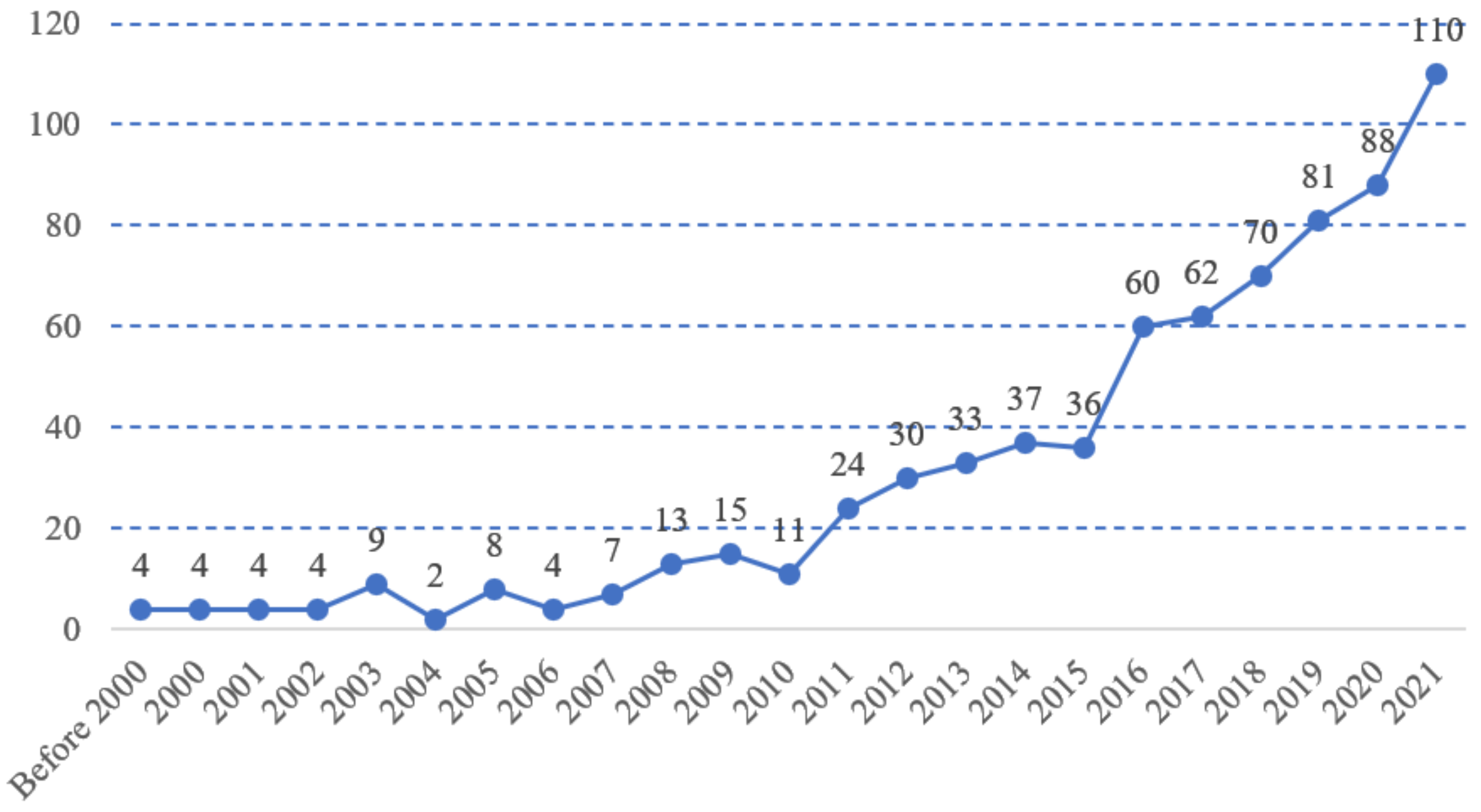
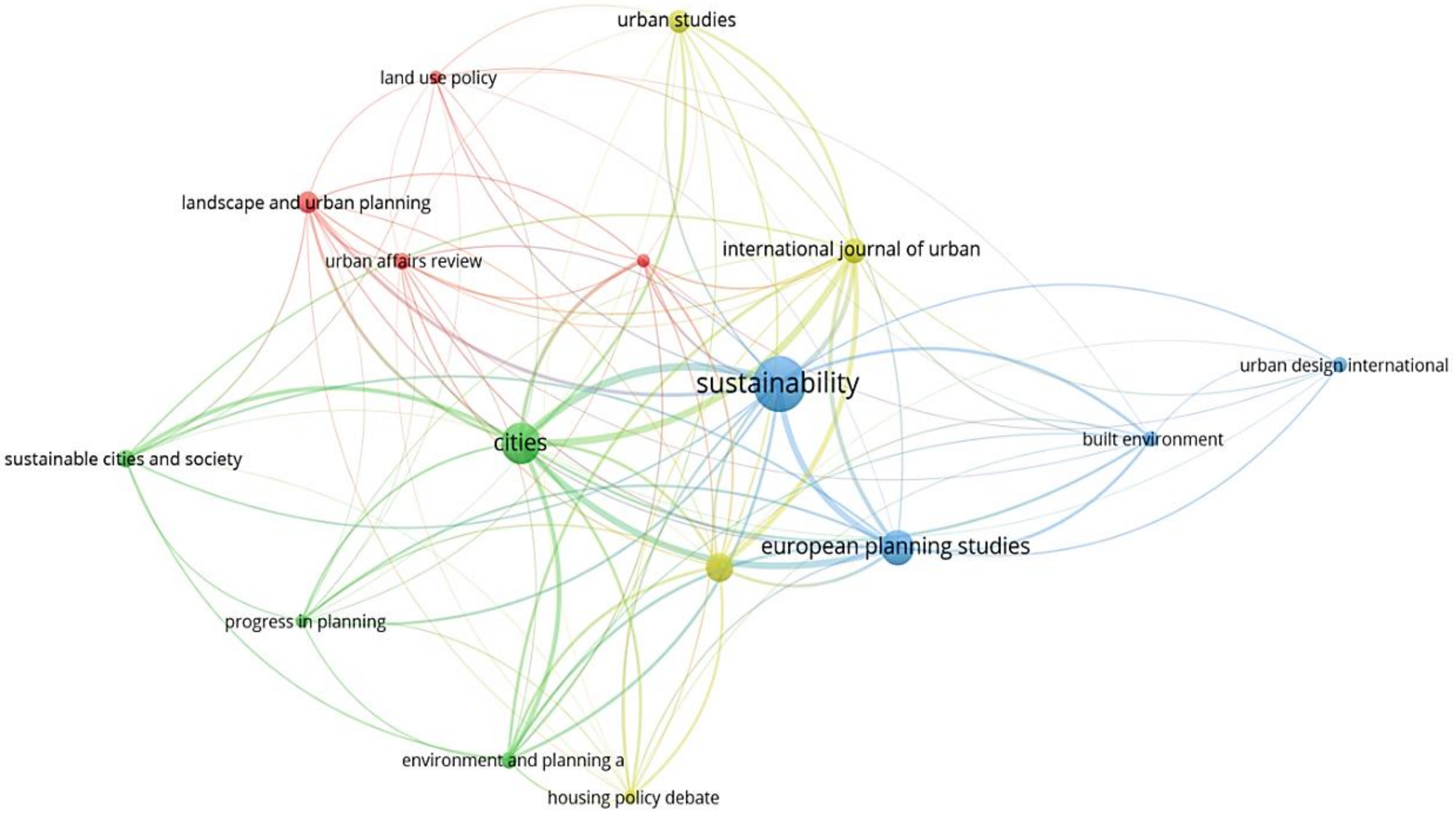
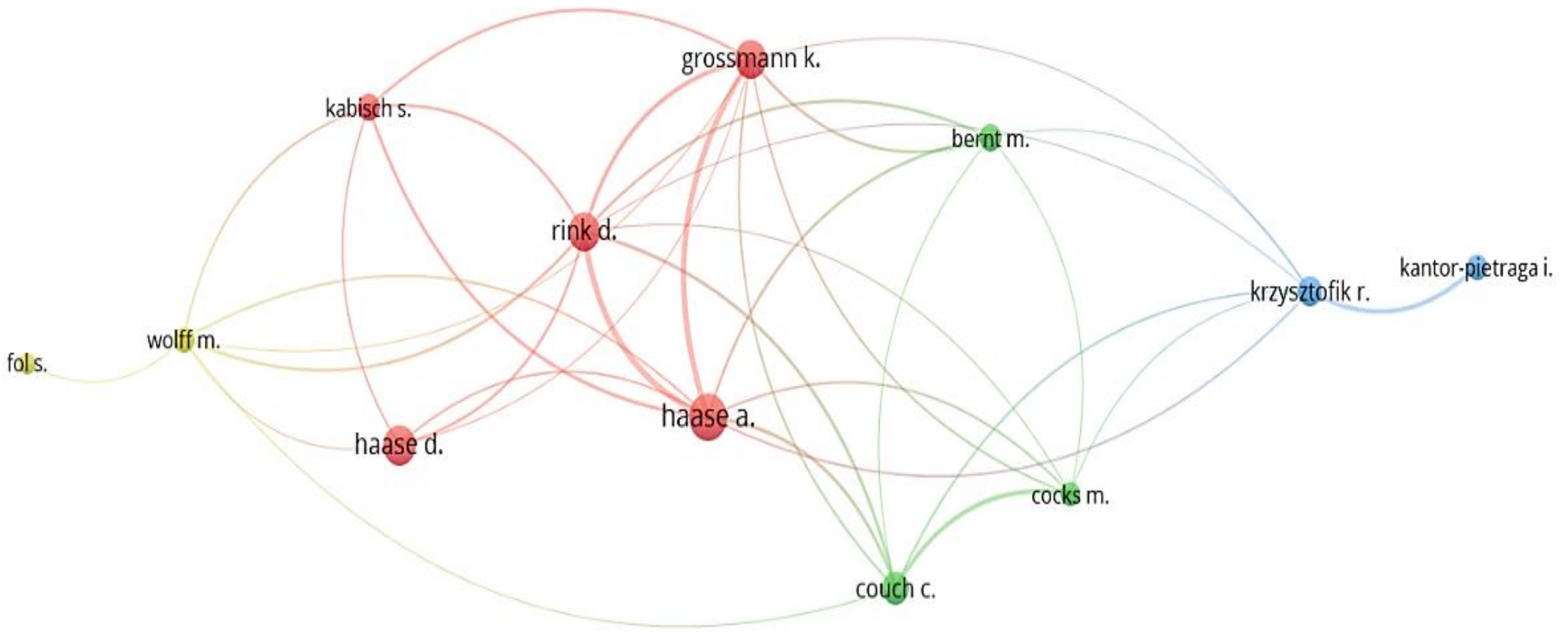
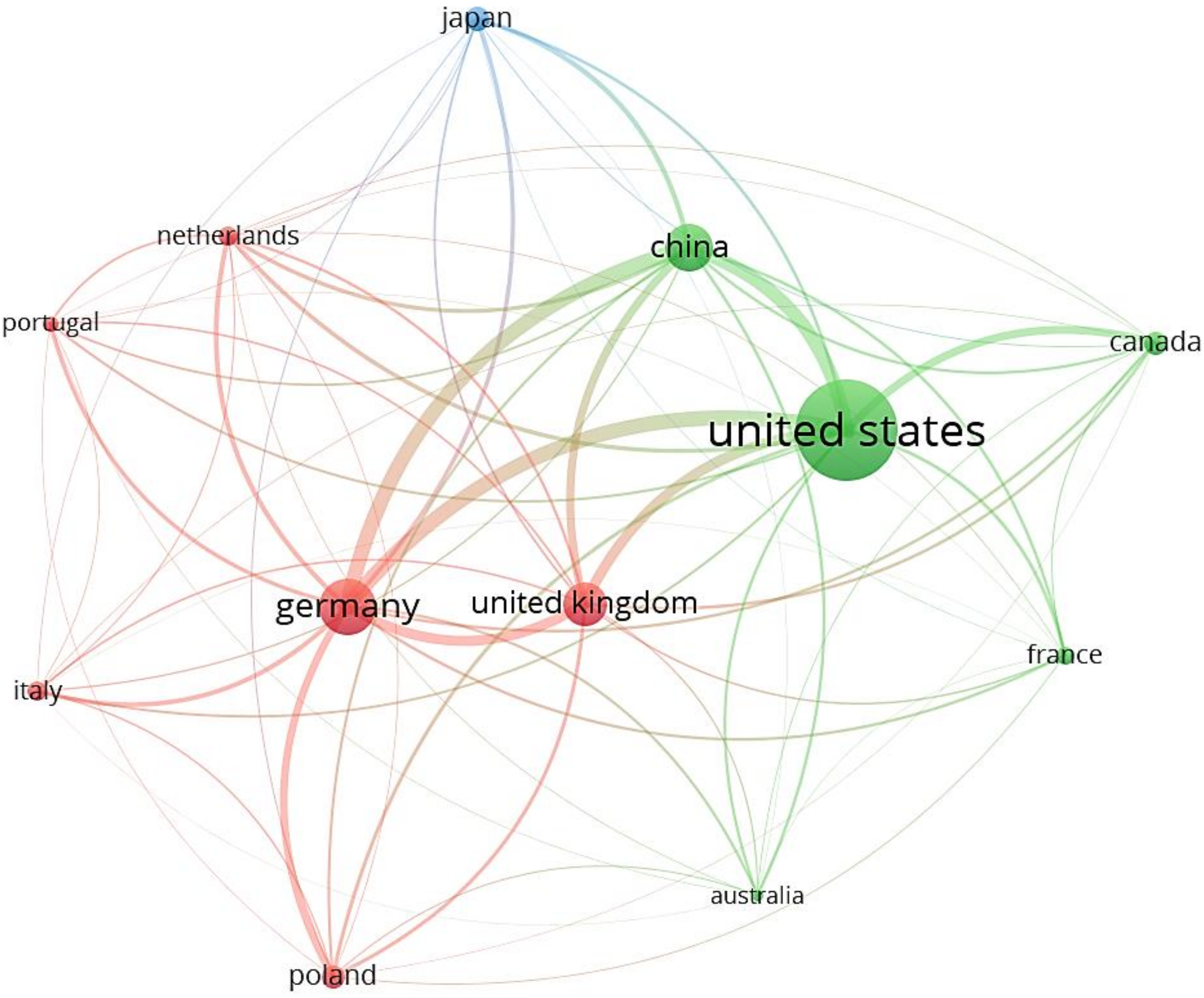

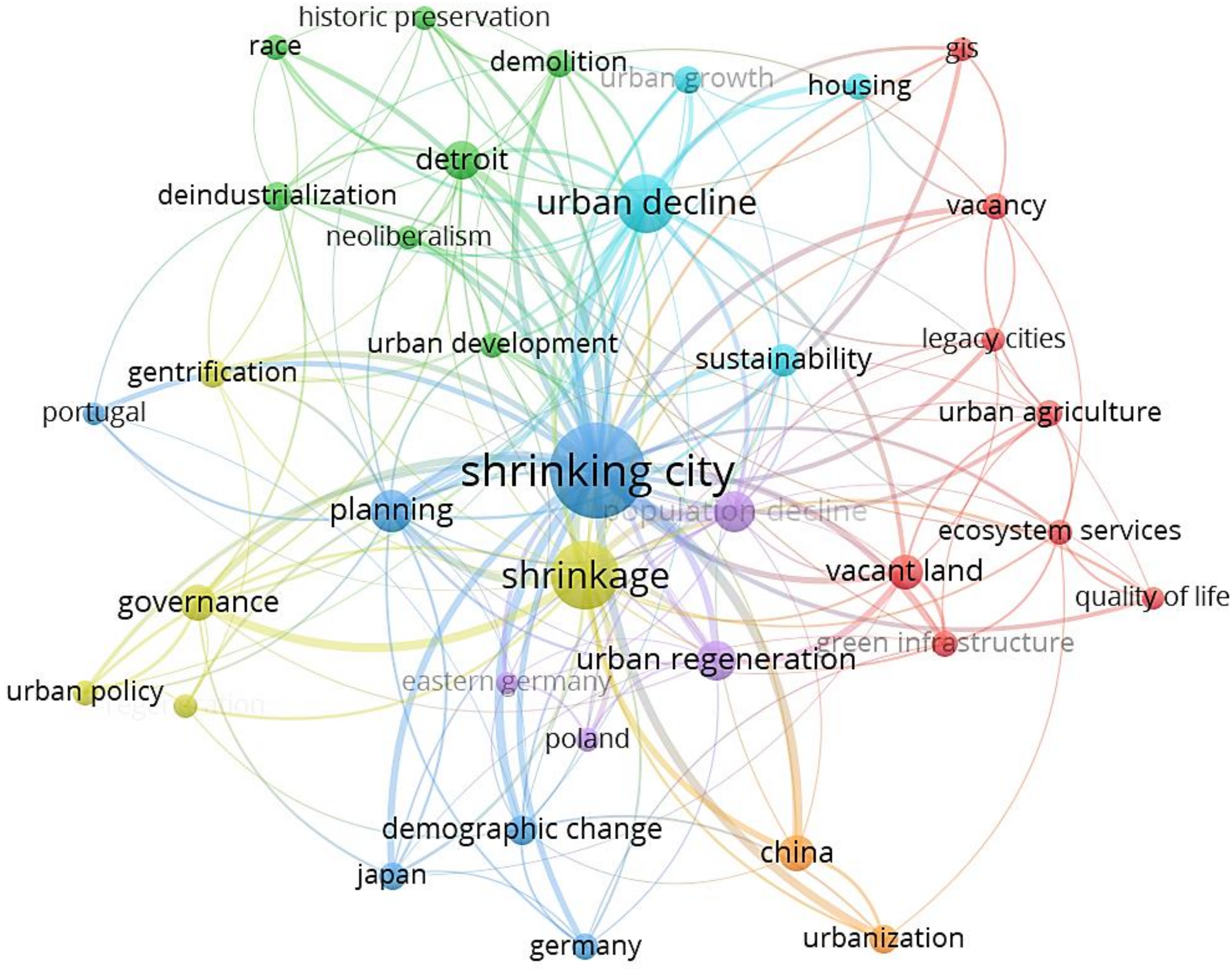
| Source | No. of Publications | Total Citations | Ave. Citations | Ave. Norm. Citations | Total Connection Strength |
|---|---|---|---|---|---|
| Sustainability | 56 | 511 | 9 | 0.7 | 216 |
| Cities | 35 | 1044 | 30 | 2.0 | 264 |
| European Planning Studies | 26 | 923 | 36 | 1.3 | 172 |
| Urban Geography | 20 | 409 | 20 | 1.0 | 119 |
| International Journal of Urban and Regional Research | 15 | 971 | 65 | 1.8 | 175 |
| Urban Studies | 13 | 410 | 32 | 1.6 | 50 |
| Landscape and Urban Planning | 12 | 716 | 60 | 2.2 | 61 |
| Sustainable Cities and Society | 9 | 188 | 21 | 2.9 | 57 |
| Environment and Planning a | 8 | 404 | 51 | 2.3 | 99 |
| Urban Affairs Review | 8 | 213 | 27 | 1.2 | 33 |
| Built Environment | 7 | 191 | 27 | 0.6 | 55 |
| Urban Design International | 7 | 115 | 16 | 0.5 | 19 |
| Housing Policy Debate | 6 | 250 | 42 | 1.8 | 61 |
| Journal of the American Planning Association | 6 | 547 | 91 | 1.9 | 64 |
| Land Use Policy | 6 | 116 | 19 | 1.4 | 22 |
| Progress in Planning | 6 | 326 | 54 | 3.3 | 51 |
| Scholar | No. of Articles | Total Citations | Ave. Year Published | Ave. Citation | Ave. Norm. Citations |
|---|---|---|---|---|---|
| Haase, Annegret | 22 | 1183 | 2015 | 54 | 2.1 |
| Haase, Dagmar | 16 | 1212 | 2013 | 76 | 2.4 |
| Grossmann, Katrin | 15 | 870 | 2015 | 58 | 2.2 |
| Rink, Dieter | 15 | 1015 | 2014 | 68 | 2.3 |
| Kabisch, Sigrun | 8 | 272 | 2014 | 34 | 1.2 |
| Wolff, Manuel | 7 | 213 | 2018 | 30 | 2.1 |
| Bernt, Matthias | 8 | 678 | 2015 | 85 | 3.0 |
| Couch, Chris | 11 | 493 | 2013 | 45 | 1.8 |
| Kantor-Pietraga, Iwona | 7 | 75 | 2019 | 11 | 1.5 |
| Krzysztofik, Robert | 9 | 190 | 2018 | 21 | 1.5 |
| Cocks, Matthew | 6 | 271 | 2013 | 45 | 1.3 |
| Fol, Sylvie | 5 | 217 | 2015 | 43 | 1.7 |
| Country | No. of Publications | No. of Citations | Ave. Year Published | Ave. Citation | Ave. Norm. Citations |
|---|---|---|---|---|---|
| United States | 243 | 5050 | 2016 | 21 | 1.0 |
| Germany | 106 | 4011 | 2015 | 38 | 1.5 |
| China | 82 | 987 | 2019 | 12 | 1.3 |
| United Kingdom | 72 | 1968 | 2015 | 27 | 1.2 |
| Japan | 32 | 487 | 2016 | 15 | 1.3 |
| Canada | 31 | 825 | 2015 | 27 | 1.4 |
| Poland | 31 | 364 | 2018 | 12 | 1.0 |
| Italy | 24 | 433 | 2017 | 18 | 0.9 |
| Netherlands | 23 | 612 | 2015 | 27 | 1.4 |
| France | 22 | 482 | 2016 | 22 | 1.2 |
| Portugal | 17 | 309 | 2017 | 18 | 0.9 |
| Australia | 9 | 302 | 2017 | 34 | 2.3 |
| Author | No. of Citations | Ave. Norm. Citations |
|---|---|---|
| Schilling and Logan (2008) [50] | 437 | 5.4 |
| Glaeser and Gyourko (2005) [51] | 387 | 4 |
| Wiechmann and Pallagst (2012) [28] | 260 | 5.6 |
| Kabisch and Haase (2013) [59] | 190 | 6.3 |
| Nemeth and Langhorst (2014) [60] | 182 | 6.3 |
| Haase et al. (2014) [24] | 178 | 6.2 |
| Hollander and Nemeth (2011) [56] | 175 | 5.1 |
| Bernt (2009) [57] | 172 | 3.5 |
| Couch et al. (2005) [61] | 167 | 1.7 |
| Grossmann et al. (2013) [58] | 151 | 5 |
| Haase et al. (2016) [52] | 148 | 6.3 |
| Rosenthal (2008) [55] | 138 | 1.7 |
| Reckien and Martinez-Fernandez (2011) [54] | 130 | 3.8 |
| Rieniets (2009) [53] | 119 | 2.5 |
| Rall and Haase (2011) [62] | 117 | 3.4 |
| Emmanuel and Kruger (2012) [63] | 113 | 2.4 |
| Wiechmann (2008) [64] | 112 | 1.4 |
| Martinez-Fernandez et al. (2016) [65] | 112 | 4.8 |
| Keywords | Occurrence | Ave. Year Published | Ave. Citation | Ave. Norm. Citations | Total Connection Strength |
|---|---|---|---|---|---|
| Shrinking City | 241 | 2017 | 20 | 1.1 | 161 |
| Shrinkage | 104 | 2018 | 18 | 1.1 | 64 |
| Urban Decline | 72 | 2015 | 16 | 0.6 | 52 |
| Planning | 34 | 2017 | 14 | 0.9 | 32 |
| Population Decline | 31 | 2018 | 13 | 1.0 | 29 |
| Urban Regeneration | 29 | 2018 | 10 | 0.8 | 23 |
| Detroit | 26 | 2017 | 14 | 0.8 | 20 |
| China | 22 | 2019 | 15 | 1.9 | 17 |
| Governance | 22 | 2016 | 23 | 1.0 | 21 |
| Vacant Land | 20 | 2017 | 37 | 1.8 | 19 |
| Sustainability | 18 | 2017 | 16 | 0.7 | 12 |
| Demographic Change | 15 | 2018 | 17 | 1.0 | 14 |
| Deindustrialization | 13 | 2015 | 22 | 0.8 | 12 |
| Gentrification | 13 | 2017 | 20 | 0.9 | 10 |
| Urbanization | 13 | 2018 | 14 | 1.5 | 12 |
| Demolition | 12 | 2016 | 29 | 0.8 | 12 |
| Japan | 12 | 2018 | 17 | 1.7 | 11 |
| Urban Growth | 12 | 2016 | 37 | 1.6 | 9 |
| Germany | 11 | 2016 | 15 | 0.7 | 9 |
| Green Infrastructure | 11 | 2016 | 66 | 2.0 | 11 |
Publisher’s Note: MDPI stays neutral with regard to jurisdictional claims in published maps and institutional affiliations. |
© 2022 by the authors. Licensee MDPI, Basel, Switzerland. This article is an open access article distributed under the terms and conditions of the Creative Commons Attribution (CC BY) license (https://creativecommons.org/licenses/by/4.0/).
Share and Cite
Wu, Z.; Zhang, D.; Li, S.; Fei, J.; Chen, C.; Tian, B.; Antwi-Afari, M.F. Visualizing and Understanding Shrinking Cities and Towns (SCT) Research: A Network Analysis. Int. J. Environ. Res. Public Health 2022, 19, 11475. https://doi.org/10.3390/ijerph191811475
Wu Z, Zhang D, Li S, Fei J, Chen C, Tian B, Antwi-Afari MF. Visualizing and Understanding Shrinking Cities and Towns (SCT) Research: A Network Analysis. International Journal of Environmental Research and Public Health. 2022; 19(18):11475. https://doi.org/10.3390/ijerph191811475
Chicago/Turabian StyleWu, Zezhou, Danting Zhang, Shenghan Li, Jianbo Fei, Changhong Chen, Bin Tian, and Maxwell Fordjour Antwi-Afari. 2022. "Visualizing and Understanding Shrinking Cities and Towns (SCT) Research: A Network Analysis" International Journal of Environmental Research and Public Health 19, no. 18: 11475. https://doi.org/10.3390/ijerph191811475
APA StyleWu, Z., Zhang, D., Li, S., Fei, J., Chen, C., Tian, B., & Antwi-Afari, M. F. (2022). Visualizing and Understanding Shrinking Cities and Towns (SCT) Research: A Network Analysis. International Journal of Environmental Research and Public Health, 19(18), 11475. https://doi.org/10.3390/ijerph191811475









